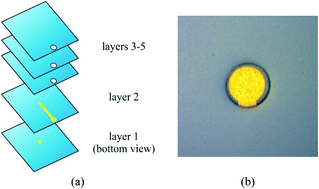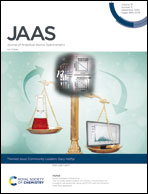A ceramic microchip with LDA-APGD as the excitation source for OES – a sensitive Hg detecting sensor for microsample analysis†
Abstract
A novel portable excitation microsource for optical emission spectrometry (OES) based on atmospheric pressure glow discharge with a liquid drop anode (LDA-APGD), generated in a ceramic microchip (mch), was developed. This excitation microsource uses low temperature cofired ceramic (LTCC) microchips to provide electrical contact and fabricate a hollow to hold a microsample solution. Optimization of this new excitation source was performed for the quantification of Hg in liquid samples and discussed. Optimal parameters for Hg determination were: polarized liquid drop – anode, discharge current – 80 mA, solution drop volume – 15 μL, He flow rate – 300 mL min−1, chip hollow dimensions: diameter 3.0 mm and depth 0.6 mm, HNO3 concentration – 0.10 mol L−1. The addition of low molecular weight organic compounds (LMWOCs) to the solution was also tested. The linearity range for mch-LDA-APGD was up to 30 mg L−1, and the limit of detection (LOD) of Hg was 47 μg L−1. Precision of this method was within 0.65–8.7% (as the relative standard deviation of repeated measurements). Recoveries obtained for tap water samples spiked with Hg(II) ions at 100, 200, and 300 μg L−1 were within the range of 96–122%.

- This article is part of the themed collection: Community Leaders: Gary Hieftje


 Please wait while we load your content...
Please wait while we load your content...